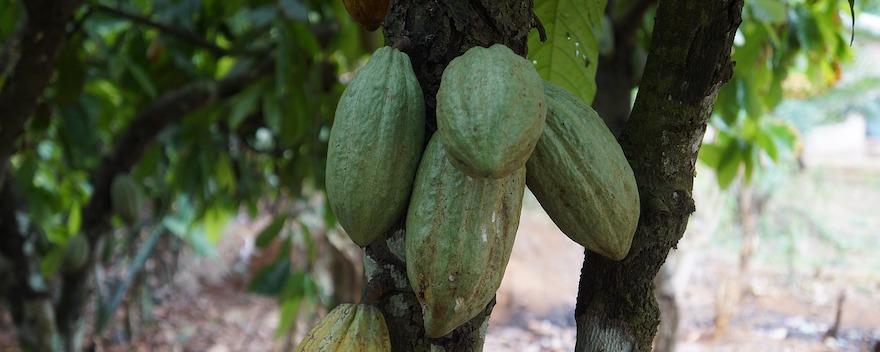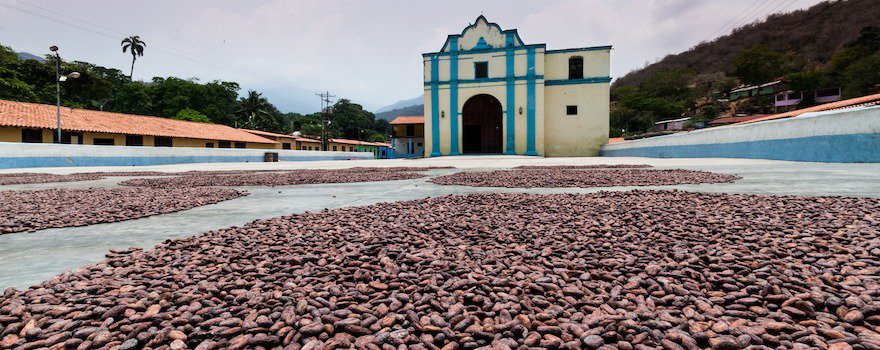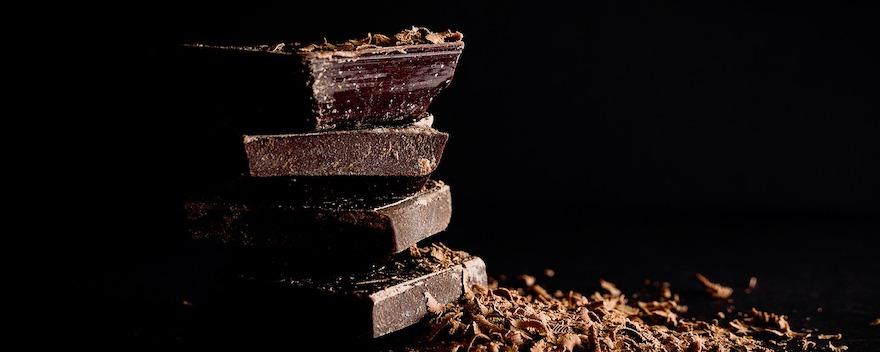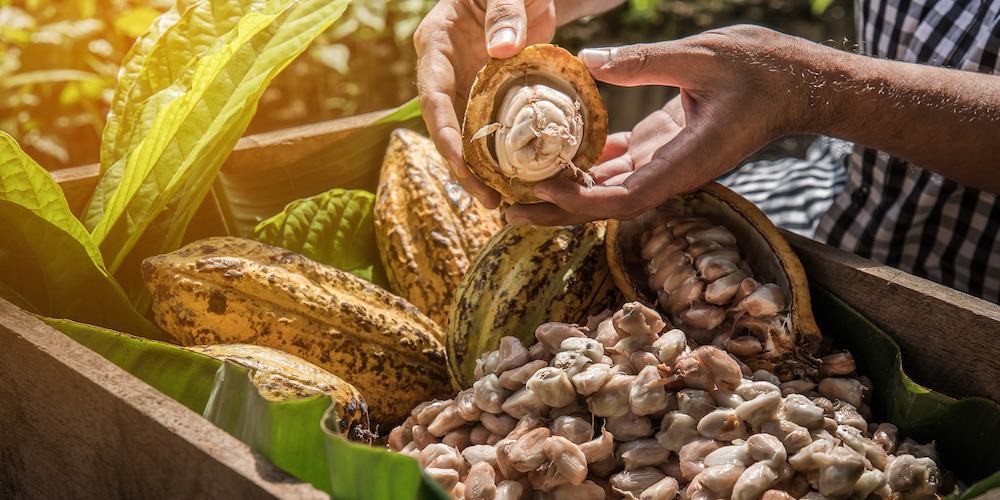What is Criollo cocoa?
The art of cocoa cultivation
From Africa to South America, including Asia, many countries cultivate cocoa. Even though the global cocoa market has become monopolized by large international firms, many small producers still make a living from growing cocoa today. Rich in ancestral know-how, they cultivate a few hectares of cacao trees and are self-sufficient, from planting to sun-drying the beans.
Also read The day we harvested cocoa in the Amazon!
Cocoa cultivation is an art that encompasses many steps: planting cacao trees, monitoring the crops, harvesting pods, shelling, fermenting the beans, then sun-drying, and selling. But it all starts with a crucial first step: selecting cocoa varieties.

The different varieties of cocoa
Today, there are various cocoa varieties, including old and hybrid varieties. Among them, only three are predominantly used by chocolatiers: Forastero, Trinitario, and Criollo.
Forastero alone represents 80% of the world’s production. This variety has been preferred over others because the tree is very productive, robust, disease-resistant, and offers an early harvest. But the choice for yield was made at the expense of taste. Indeed, Forastero beans are rich in tannins, giving them an acidic and very bitter flavor.
The Trinitario variety, on the other hand, is a hybrid resulting from the crossing of Criollo and Forastero. Thus, it combines some of the taste qualities of one with the yield capabilities of the other. A Trinitario cacao tree can produce 150 pods a year. But this variety has an acidity that may not be appreciated.
The specifics of Criollo cocoa
The Criollo variety is the most refined and noble. It represents only 5% of the worldwide production. Criollo pods are usually green, but some sub-varieties are red. As they mature, they turn yellow or yellow-orange. They have a powerful, fine, and aromatic taste. Very low in acidity and almost without bitterness, Criollo is the most interesting from an aromatic perspective.

However, this high-quality variety is little produced worldwide. Delicate to cultivate and fragile, it grows slowly and has a low yield. Additionally, the Criollo cacao tree is sensitive to diseases and poorly withstands climate change, which threatens the global cocoa production. This is why more productive and resistant varieties are often preferred, even though they are much less appealing to the tastebuds.
The history and development of Criollo
Origin and discovery
At the beginning of the colonization of America, the Spanish took an interest in the cultivation of cacao trees by local populations, notably in Mexico. The Aztec people then dominated Central America. They used cocoa for economic purposes (as a currency of exchange) and ritual purposes.
Not fond of the original recipes for Aztec drinks made from Criollo cocoa (xocoatl), which were rather bitter and spicy, the Spanish decided to sweeten it by adding cane sugar and honey. Entire loads of cocoa were brought back to Spain, where, transformed into chocolate or drinks, it became widely popular.
To meet the growing demand, the Spanish wanted to develop cocoa cultivation in America. In 1525, they chose the island of Trinidad, off the coast of Venezuela, to plant Criollo cacao trees. Criollo means “Creole” in old Spanish.

Meanwhile, exchanges allowed for the discovery of a new variety of cocoa with purple beans. To distinguish it from Criollo, it was named “Forastero” or “foreigner” in Spanish.
In 1727, a hurricane and an epidemic of Phytophthora fungus decimated much of the Criollo plantations on the island of Trinidad. Forastero, less fragile, more robust, and productive, was then planted. The two varieties mixed, leading to the hybrid Trinitario. Its cultivation gradually surpassed that of Criollo cocoa.
The cultivation of Criollo today
Even though it represents only a tiny fraction of the world’s cocoa production, the criollo bean remains the most popular from a taste perspective. Today, it is mainly cultivated in Central America and South America, in the Caribbean, Peru, Mexico, Venezuela, and Colombia.
In Venezuela, of the 6,000 tons of cocoa produced each year, only 3% belong to the criollo variety. The small village of Chuao, located west of Caracas, is known for producing the best cocoa in the world: a criollo cultivated under an ideal microclimate and processed according to artisanal methods unchanged for 400 years. Barely 20 tons of criollo beans are harvested and exported each year. But the success of criollo lies in its rarity and preciousness.

Today, the criollo variety is used in cocoa breeding programs and in the development of new varieties.
Why choose criollo cocoa?
When you choose your next chocolate bar, we encourage you to discover the criollo variety, not only for its taste qualities but also to support major issues.
The intense taste of criollo chocolate
It’s no wonder the criollo variety is prized and sought after by great chocolatiers. All chocolate lovers agree: it is the only one to offer flavors that are both complex, intense, and delicate.
The taste of criollo beans can also vary from one production region to another, allowing for a wide and varied aroma palette. The taste of cocoa is expressed in terroirs, much like wine. Criollo is also interesting for its fruity secondary notes that linger in the mouth. You can find hints of nuts, caramel, and even blueberries!

Support for small local producers
Because it does not offer a sufficiently significant yield, the criollo variety is overlooked by major leading chocolate companies (Hershey, Ferrero, Lindt…). Part of its cultivation is thus ensured by small local producers. By opting for this variety, we financially support and contribute to safeguarding ancestral know-how.
The preservation of an ancient variety
Gradually, ancient varieties of cocoa have been replaced by hybrid varieties. That’s how agronomists created the CCN-51, resulting from a cross between iquitos/criollo/amelonado varieties, or the “Mercedes” cocoa.
This latter offers record yields and produces in just 18 months, compared to 4 to 5 years for a classic cocoa tree. The global cocoa market thus seems to be banking on hybrid varieties to meet demand, even if it means producing chocolate with standardized flavors.
On the other hand, ancient varieties are struggling to survive. Today, as we’ve seen, criollo represents no more than 5% of global production. By purchasing criollo cocoa, one has the opportunity to contribute to the preservation of this ancient and local variety.



